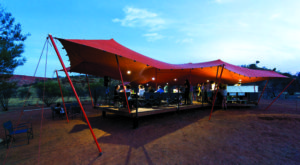
Photo: Stretch Marquees & Fabric Structures.
Tent manufacturers, rental companies and event planners are stretching their boundaries with new tent shapes and flexible materials.
Consider, if you will, the Pythagoreans, who dissected a sphere as early as 600 B.C. Latecomers like Plato and Buckminster Fuller took the ball and ran with it, so to speak. But in 2015, Platonic polyhedral/geodesic domes are still fresh on the scene when it comes to tented events. After all, rental tents are typically peaked rectangles—except in certain circles.
Case in point: Zenvision GmbH of Berlin, Germany, introduced its patented dome-shaped tent less than a decade ago. The company also markets Zencube, as well as immersive media screens as add-ons.
“With cupolas and planetary-style domes, we serve the full range of a 360-degree projection market,” says Gordian Overschmidt, chief marketing officer. “Our client base is innovative, early adopters,” he continues, adding that nontraditional tent shapes represent “simply places for ideas.”
History also serves Tentipi Ltd., producing tents for adventure and events inspired by the traditional, cone-shaped Nordic tents of the Lapland. Unusually shaped tents provide “the ability to wow an audience by offering something unexpected,” says Jon Parr, managing director of Tentipi’s main distributor in Little London, England. Founded 25 years ago in the Lapland, in Sweden, Tentipi still makes tents there today.
Although the company is dedicated to one style, it has developed a gusset system allowing the tent to be pitched like a giant witch’s hat. This ability to raise the sides makes it possible to link tents into a range of nontraditional configurations. Six tents can be laid out in a “T” shape or as a flower. Link 18 tents and you have a tire, so you could, for instance, host a covered dinner party and have a band playing in the center. Tentipi linked 34 of its tents for a ski-jumping competition in Norway, during which dinner for 2,000 was served under the complex of cones.
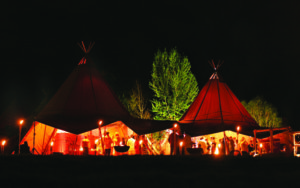
Because unconventionality serves as the foundation of Burning Man festival, what better place could there be to introduce an unconventional tent? Last August, Nomad Tents USA LLC of Fort Lauderdale, Fla., used the annual gathering to debut its eight-sided Octobar tent, as well as test it in the harsh environment of the Nevada desert.
According to owner Bradley Morris, Nomad set up almost a dozen tents to provide 10,000 square feet of protection from the sun. Burning Man attendees set up between 20 and 30 camp tents under Nomad’s largest stretch tent: the 4,250-square-foot Octobar.
Michele Upton, managing director of Maverick Tents in Plettenberg Bay, South Africa, points out that stretch tents can be shaped many different ways by setting poles at staggered lengths, and can be rigged over, under and around other structures.
“The market is primed for nontraditional structures,” she says. “Stretch tents are no longer a novelty locally. Event organizers and rental companies are looking to add unique tents to their rental stock.”
“The goal of different shapes is to give the end user the sense of a high-end structure with form following function,” says Jeff McInnes, North America sales manager for HTS-USA in Delray Beach, Fla., whose client list includes heavy-hitters in the consumer products market. “It’s best to showcase high-end products with a structure of quality and design elements. These [nontraditional] systems allow avant-garde creativity.”
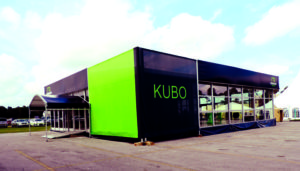
For years, HTS has offered hexagons, octagons and decagons. Its newest shapes include the Manhattan tent, featuring a 7-degree-pitch roofline, a valance for signage that conceals the roofline, and cantilevered roofs over upper-level decks. The Icon, with a 12-degree pitch and curved apex, can be installed asymmetrically—for example, with 3-meter legs on one side and 5-meter legs on the other. The company also has a new series of cube-style pagodas intended primarily to augment larger structures.
To market, to market
“Whatever the event, structure is commensurate with image. It’s driven in a collaborative way with experiential marketing companies. Tent manufacturers are listening to the end users and visionaries and creating collaborative environments,” McInnes says. “The market has changed in the sense that some tent and event rental companies are differentiating themselves to invest in high-end products. They’re winning projects on design criteria instead of lower cost-per-square-foot, which is good for the industry.”
Like HTS’ Manhattan and Icon structures, Losberger’s Kubo features a 7-degree-pitch roofline. “All the way around the perimeter, we put a 4-foot-high signage board that conceals the roof slope,” says David MacArthur, national sales manager for Losberger US. “It’s used by corporations primarily interested in branding at sporting events, product launches and trade shows. It gives them the opportunity to have signage that’s up 12 to 13 feet in the air.” Losberger’s Palas gets the signage even higher with 24-foot sidewalls.
The 5-by-5-meter Cyclone series is “nothing weird,” MacArthur says, but connected they can make “U” and “Z” shapes. Design-oriented car companies such as BMW, Mercedes and Audi like them for ride-and-drive events, MacArthur says. “We haven’t sold many yet because they’re like gold when they’re tricked out—and you don’t buy this type of structure without tricking it out.”
“Nontraditional shapes mean that companies can use tents as part of their own marketing and design,” says Stuart Johnstone, owner of Stretch Marquees and Fabric Structures in Sydney, Australia. “Various shapes provide the opportunity for structures to blend into the environment, while making it easy to adapt to unusual spaces. The shapes and configurations of stretch tents are truly up to the imagination of the customer.”
Stretch Marquees’ newest products include an integrated flooring system, clear fabric and glazed-wall options, and retrofit skins for clearspan pavilions and pagodas, the latter aimed at maximizing rental companies’ return on existing stock while providing them a new style to offer clients.
“With consumers being bombarded by the latest and greatest marketing techniques, companies are always interested in ways to capture their audience’s attention,” Johnstone says. “New designs are always a hit. When great quality meets innovative design, marketing is simply a matter of sharing what’s available.”
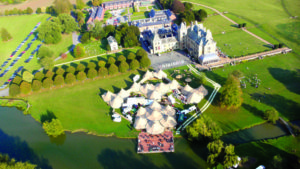
That’s exactly what Nomad Tents is doing. “The best way to get people interested is to have the product in hand,” Morris says. “We do demos for specific markets.”
Like MacArthur and Johnstone, Morris recognizes the importance in adapting temporary structures to a corporation’s identity. “The Octobar generally goes up the same way as our other tents, so we have engineered clear and colored drop sides that offer a cheap branding option for each customer.”
Style matters
“Style is the biggest benefit [of a stretch tent], and you can set it up with four guys in four hours,” Morris says. “You can mold it; it doesn’t have to go up the same way every time. You can put the poles in different locations, and you can move those poles in a matter of minutes.”
While clearspan structures offer unobstructed views, working around stretch tent poles is easy, Morris contends. “They’re only 3 inches wide. You do see a pole in the center, but it’s not as bad as a large pole tent.”
According to Upton, stretch-tent poles can be “cleverly arranged so as not to create any obstruction.” Their main limitation is that, because they lack drop sides, they are not ideal in very cold climates. However, Upton says, the tents go up more quickly than traditional structures and need no specialized equipment.
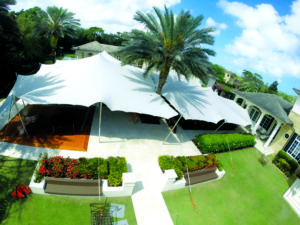
“As few as two riggers can erect a 15-by-10-meter tent,” she says. “We have erected large structures within two hours.”
Another plus: “Because of the natural contours of the tent, abstract graphics look stunning, and color makes the tent ‘pop,’” Upton says. “We have even had clients who run cinematic film using the tent as a backdrop.”
“The exciting thing about working with stretch tents is that they can become part of the architecture. No longer do event planners have to work around stiff structures,” Johnstone says. “The tent itself acts as a foundation for providing other creative elements.”
Just as geodesic dome houses had their limitations (where do you hang artwork and place furniture?), geodesic domes — like other unconventional shapes—have their limitations. But, Zenvision’s Overschmidt says, “The limits are more with the potentials of the industry to come up with new ideas and technical improvements.”
As for Tentipi’s cone-shaped structures, Parr admits they lack headroom around the interior edge. “The fact that the sides slope has to be considered when creating floor plans,” he says. With an open-brim configuration, however, space limitations can be overcome with walls fitted to the edge of the brim to create a larger space sheltered from the elements.
Tentipi’s key market is tent-rental companies “looking to offer their customers something very different, something with a natural feel and quirky possibilities,” Parr says. The tents require no special tools, but call for specialized instruction, especially in the ways they are linked.
“We have a sophisticated training program covering every step of building, dismantling and linking in great detail. We have a 200-page interactive PDF file, 40 videos and face-to-face training.”
There’s a learning curve for companies that acquire Manhattan and Icon tents; but McInnes says, “We have found that, with the skill set of any company that owns clearspans, after the first build, they are proficient at erecting the product and have implemented their best practices. The frames typically don’t take that much longer to install once the crew is familiar with them.”
Zenvision’s tents require no special equipment, but, Overschmidt says, training is necessary, so the company provides coaching. “We had one client who set up a 75-square-meter Zendome within one-tenth of the time we give as an approximation,” he says. “With the right passion, most everything is possible.”
Janice Kleinschmidt is a writer and editor based in San Diego, Calif.

Recently, a Zenvision customer requested a shining silver “kickball” of a structure. It seems that event planners aren’t letting costs prevent them from getting what they want. “How does a Porsche or BMW compare to Volvo? It’s always a question about your needs and expectations,” says Zenvision’s Gordian Overschmidt.
According to Maverick Tents’ Michele Upton, stretch tents are more expensive to rent “because of their uniqueness, which encompasses form and function.”
“We are on the high end of the rental market purely because it’s a specialty product,” says Nomad Tents’ Bradley Morris. “We do quality over quantity.”
Stretch Marquees’ Stuart Johnstone contends that stretch tents are more cost effective than traditional tents. “There are savings in shipping and storage due to their lightweight nature and compact design,” he says. “The greatest savings is in labor charges, as stretch tents are far easier and quicker to install.”
HTS’ more unusual structures do not bear a “significantly higher” price tag, but the manufacturer and customers absorb some additional engineering costs, says sales manager Jeff McInnes. “It involves upfront research and design effort, making sure they will work and meet engineering load criteria, which are becoming more stringent,” he says. “We have 15 engineers and designers on staff full-time in Germany, plus two U.S. engineers. For each new shape and innovative product, we allocate staff to create a purposefully designed structure.”
According to David MacArthur, Losberger’s nontraditional tents cost more than a typical clearspan structure because of the additional hardware required. “Usually these tents are fitted out with glass sidewalls,” he says. “Where a sidewall of fabric might cost $600, a glass sidewall would be $2,500. The engineered flooring systems integrated into the tent run somewhere in the neighborhood of $12 to $15 per square foot. You could use a laydown floor, but that would cheapen the product.”
Stretch tent fabric is “very technical and continually evolving,” says Michele Upton, owner of Maverick Tents. “We recently purchased a textile factory in Cape Town where we are able to knit, process and coat or laminate stretch tent fabric. Our current development is a coated product that offers the same longevity, UV and FR standard as the automotive industry. We are excited about the future of technical textiles, which may include revolutionary developments such as photovoltaic stretch fabrics.
“As the fabric becomes more technically advanced, so, too, will applications change. Stretch tents of the future could be highly engineered, mobile shelters able to withstand the most hostile environments while generating their own power and trapping and storing their own water, or even stretched solar panels that can be erected anywhere, generating solar power as required. We are very excited about the future of this industry and the innovations to come.”
 TEXTILES.ORG
TEXTILES.ORG


